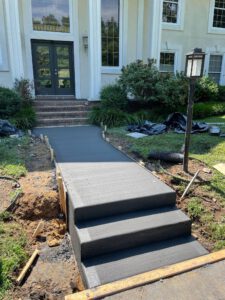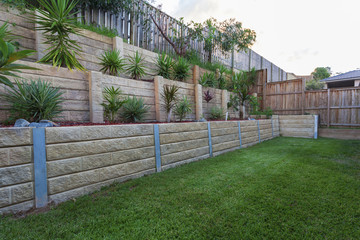Regarding concrete walkways, homeowners can choose from many different materials. Each has its advantages and disadvantages. Concrete, however, has several advantages that make it a popular choice.
For example, a dark concrete walkway can exude masculine charm by blending the hardiness of concrete with the raw beauty of landscaping pebbles. It also offers an attractive alternative to weed-prone, trip-hazard paver walkways. Click https://concretecontractorcoloradosprings.com/ to learn more.

Concrete is one of the most affordable paving materials for walkways. It also requires very little maintenance and repairs compared to other paving materials. Its durability and low cost make it a popular choice for homeowners looking to upgrade their outdoor space. However, the cost of a concrete walkway can vary greatly depending on the size, shape, and style you choose. In addition to the actual cost of the concrete, you will need to consider other costs associated with the construction process, such as labor and material costs.
A basic concrete walkway typically costs around $6 to $10 per square foot. This includes the concrete itself and any finishing touches. If you opt for a decorative finish, you must add more to the budget, as these options are expensive. It would be best if you always got quotes from multiple contractors to ensure you get the best price for your project.
Some of the most common concrete finishes include stamped, colored, and antiquing. The cost of these treatments is based on the level of detail, complexity, and labor involved. It would be best to use a contractor experienced with these processes to achieve the most realistic appearance. They can help you select a design that will complement your home and yard while staying within your budget.
Another way to increase the visual appeal of your concrete walkway is to stain it with earth-toned colors. This technique creates a natural look that blends with your home and landscape. Staining your concrete will protect it from the sun’s harsh UV rays.
Adding a vapor barrier under your concrete will help prevent cracking due to freeze-thaw cycles. This is especially important if you live in an area with cold temperatures. A vapor barrier usually costs about $1 per square foot.
For a more creative walkway, try concrete pavers with grass inlays. This combination creates a symphony of textures that captures the essence of strength and serenity. This is a perfect walkway for men who appreciate contrasts and want to bring a sense of nature to their outdoor space.
Concrete is a popular choice for building large structures like bridges and roads, but it can also be used for smaller creations such as walkways. This is a great option for homeowners who want a durable and long-lasting path that can be installed quickly. Concrete walkways are less expensive than pavers and can be poured in any shape or curve.
Concrete can be stamped to resemble other materials, creating a unique and customized appearance for your walkway. In addition, concrete can be stained or colored to match your landscape. This can create a cohesive and visually appealing walkway that complements your home and landscape.
To construct a concrete walkway, you must prepare the project site by removing existing grass and adding dirt or gravel. Then, use a QUIKRETE Walkmaker form to create the base of your walkway. Once the form is in place, shovel wet concrete into each cavity using a trowel. When the concrete is at its maximum slump, smooth it with a bull float to achieve a nonslip finish.
Reinforcement can help increase the durability of a concrete sidewalk, preventing cracking during expansion or contraction cycles. Some types of reinforcement include steel rebar or mesh. Alternatively, you can add expansion joints to your concrete walkway. These joints can be formed by inserting pre-made foam or rubber strips into the concrete during pouring.
For a more modern look, try a herringbone pattern concrete walkway. This intricate design is a testament to sophistication and craftsmanship; each interlocking section tells a story of precision and elegance.
A contrasting brick border can accentuate the concrete walkway, providing an added touch of style and character. If you plant flowers or shrubs on your walkway, keep them away from the surface. Many fertilizers contain iron, which can stain the concrete if wet. You may also consider a concrete resurfacing application, such as TruStainTM, penetrating the concrete to provide color without wearing off over time. These applications are less costly and messier than tearing out and replacing your walkways.
Concrete walkways are one of the most durable paving materials available. They withstand a multitude of elements, including scalding heat and icy chill. They also stand up to erosion. When the proper construction techniques are used, a concrete sidewalk can last for decades without much maintenance. Unlike other types of paving requiring periodic treatments, a concrete walkway requires only the occasional sweep and wash to maintain its integrity.
Sidewalks are essential for pedestrian safety and the overall aesthetic of a home. If the walkways are damaged, restoring them as soon as possible is important. This will help avoid trips and accidents and prevent water from leaking into the home’s foundation. The best way to do this is to hire a professional contractor with the necessary experience to perform the repairs.
Several steps need to be considered, whether you are building new concrete or renovating an existing walkway. The first step is to prepare the area by removing any grass, dirt, or gravel that may be present. The area should then be tamped and sprayed with a chemical that helps to stabilize the soil and prevent it from shifting while the walk is being poured.
After pouring the concrete, it usually cures for at least three days. Then, the forms are removed, and the concrete is cut into slabs of six feet and a maximum length of two feet. The edges of each slab are rounded with a one-fourth-inch radius. The joints are saw-cut contraction joints typically placed at one-fifth of the total slab depth. A chalk line is snapped at each cut interval to mark the location of the cuts.
The cost of a new concrete walkway will depend on the size and complexity of the job, but you can expect it to be considerably less expensive than other paving materials. In addition, a concrete walkway can be stained in various colors and made to look like other surfacing materials, such as cobblestones or tile.
A concrete walkway is more than a simple path from one point to another. It is a canvas for creative expression and can enhance the curb appeal of any property. In addition, it provides a convenient and safe passage for pedestrians.
Concrete walkways come in various colors and can be easily shaped to complement the surrounding landscape. They can also be stamped with different designs, adding depth and visual interest to the surface. They can even be stained with earth-toned color combinations to match the colors of nearby plants and trees.
Whether a pathway is designed for a public space or a private backyard, it can be a work of art that reflects the personality and style of the homeowner. Using a mix of color, form, and texture, concrete can transform into a beautiful, distinctive walkway that adds value to the home.
In the public arena, colorful walkways are often used to create an inviting tableau and to direct pedestrians. In addition, they are useful for establishing themes and creating continuity throughout the landscape. A popular method for coloring sidewalks is chemical staining. This process can be combined with integral color, dry shake hardeners, and other concrete finishing techniques to create a unique and multi-tonal effect.
For residential homeowners, concrete walkways can be a practical and durable solution for a sloping yard. However, it is important to note that primary residential walkways should not slope more than 2% if they are intended for wheelchair access, as this can be dangerous if covered in ice. To avoid this, contractors can install a series of wide steps instead of a sloped walkway.
Concrete can be poured into oversized pavers to make a contemporary walkway look like giant stepping stones. These can be used in straight or curved lines to create a bold geometric pattern. For a more natural feel, a walkway can be molded to follow the curves of a garden or pond. Concrete can also be stamped with patterns that emulate stone, brick, or tile to create a custom look.

